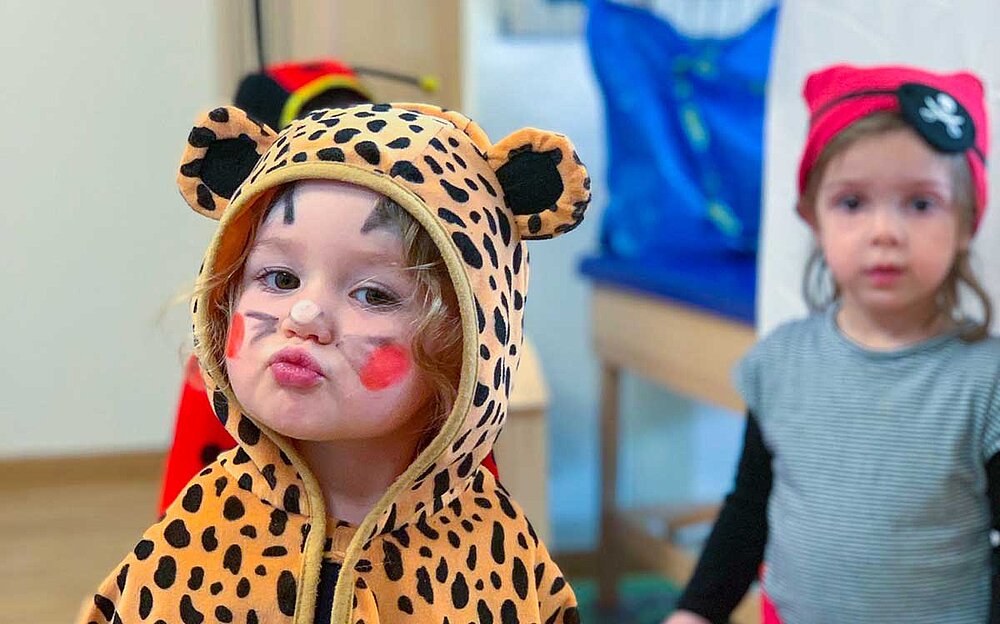Fasnacht - why dressing up makes children strong

Soon it will be high time again: The fifth season begins and until the end of February carnival fever is rampant all over Switzerland.
Whether it’s Brother Fritschi in Lucerne, King Rabadan in Ticino or Prince Carnival in Biel - everywhere, winter is chased away with much fanfare and colorful costumes. But it’s not just adults who look forward to the colorful hustle and bustle – Fasnacht is also an exciting spectacle for the little ones. Especially when they are allowed to participate and dress up themselves.
Role play is important for development
Children love to slip into other characters – not just at carnival, but all year round. They play father-mother-child, hospital, circus, gang of robbers or wild animals in the jungle, or whatever strikes their fancy at the moment. And that’s a good thing. Because role play promotes children’s social development. They get to grips with the world of adults, learn to empathize with others and process everyday situations through play. Above all, however, they need teammates, they have to communicate with them, come to terms with them and also test out how the other person reacts to me if, for example, I am a real dangerous creature.
Role-playing begins at around three years of age, but children often continue to enjoy it well into their elementary school years. For the daycare and preschool years, they are a very typical and frequent form of play. At globegarden, we also proactively encourage this important method of learning by, for example, providing the children with many props for dressing up and putting on make-up.
Fasnacht – tradition, fun and a change of perspective
Now in February, however, the topic of dressing up is naturally particularly present. To help the children understand the background, we talk to them about the tradition of Fasnacht, which has been practiced since the Middle Ages and whose customs are still preserved. But because exuberance and fun should not be neglected, we also want to celebrate Fasnacht, which, by the way, even experts advocate. “Everything that a child is not otherwise, because it is actually too small or too powerless, it can now try out,” says developmental psychologist and family researcher Hartmut Kasten from Munich. And Swiss psychologist Sonja Perren, who researches the fantasy play of kindergarten children at University of Konstanz and Thurgau University of Education, found out: “Children who are good at the ‘as-if game’ can better take other perspectives, name the feelings of others and have better relationships with the other children.”
So we at globegarden are looking forward to celebrating a happy carnival together. And of course we will support you as parents at any time when it comes to questions about dressing up or choosing a costume for your children. Here are a few tips and inspirations in advance. Have fun!
Make-up – but safely!
Cat face, mustache or princess glitter: It is best to choose natural make-up, preferably water-based, as the skin can breathe better underneath. By no means should it contain parabens, mineral oils and perfume. Check for compatibility by applying a small amount of product to a small area of skin 24 hours before use. In addition, to avoid skin irritation, apply a skin care cream before applying make-up.
To each his own: Choice of disguise
Do you see a princess in your little daughter? Or do you want your son to go to the carnival as a professor because he’s just such a smart little guy? Then you may be right in your assessment. But: allow your child to choose the role he or she wants to take on for a few great days. Maybe your daughter would rather live out her hitherto unseen wild side as Pippi Longstocking. And your bookworm finally wants to play the invincible superhero.
Quickly made: last minute costumes
You didn’t have time to get a costume and tomorrow your darling needs a disguise? Here are a few DIY ideas that you can quickly conjure up with things that you usually have at home or can quickly get at the nearest supermarket. All suggestions are suitable for girls as well as boys, of course.
Pirate costume
You will need: an old, tattered pair of jeans, a too big T-shirt, a scarf or belt, a necklace, some costume jewelry (earring), possibly a wooden saber.
How to do it: Cut jeans at different heights and fray them, “embellish” a shirt with holes and pull it together at the belly with a scarf or belt. Tie a scarf around the head. Simply paint on eye patch, as well as a few tattoos (for example, skull). As accessories serve, for example, an earring and toy saber.
Tiger costume
You will need: black pants, black shirt, hairband, black felt fabric or thick black paper and orange tape
How to do it: Cut out different sized tiger stripes from the tape and spread them on the pants and top. Cut out pointed ears from the paper or fabric and glue them to the headband. Apply make-up to tiger face.
Scarecrow costume
You will need: Dresses, shirts, shoes, scarves that you were going to throw in the clothing donation, a hat or cap and some straw.
How to do it: Toss clothes together wildly, add holes or colorful patches of fabric. Attach straw to the hat or cap. Apply funny make-up to the face.
Sheep costume
You’ll need: black pants, a white hoodie, black felt fabric and lots of cotton balls.
How to do it: Glue cotton balls all over the hoodie and to the hem of the pants (works best with hot glue). Cut two small ears out of felt fabric and glue them to the hood. Make up the sheep face.

